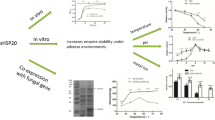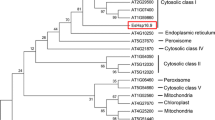Abstract
Oenococcus oeni can exert its function in hostile wine conditions during the malolactic fermentation process. Therefore, it is an important microbial resource for exploring resistance genes. Hsp20 is an important small heat shock protein from O. oeni. The conserved consensus motif “A-x-x-x-x-G-x-L” of Hsp20 announced its role as a member of the small heat shock protein family. The hsp20 gene from O. oeni SD-2a was cloned to create the recombinant plasmid pTriEx-Hsp20. The recombinant plasmid was transformed into Escherichia coli BL21(DE3) competent cells, and the Hsp20 protein was induced by isopropyl-β-d-thiogalactoside (IPTG). The hsp20 gene from O. oeni SD-2a was successfully expressed, and a 20-kDa fusion protein was identified by SDS-PAGE. The purified Hsp20 protein was obtained using Ni-affinity chromatography. Additionally, BL21(DE3)/Hsp20 and BL21(DE3)/Ctrl were treated at high temperatures of 42 and 52 °C, at pH values of 2.0–12.0, under oxidative shock with 0.1% (v/v) and 0.2% (v/v) H2O2, and under an osmotic shock of 430 and 860 mM NaCl to compare the effects of heterologous expression of the Hsp20 protein from O. oeni SD-2a for stress resistance. Notably, Hsp20 overexpression showed enhanced resistance than the control strain did when confronted with different elevated stress conditions. The results demonstrated heterologous expression of the hsp20 gene from O. oeni SD-2a significantly improved the resistance of the host E. coli bacteria against stress conditions.





Similar content being viewed by others
References
Guzzo J (2012) Biotechnical applications of small heat shock proteins from bacteria. Int J Biochem Cell Biol 44(10):1698–1705. https://doi.org/10.1016/j.biocel.2012.06.007
Horváth I, Glatz A, Nakamoto H, Mishkind ML, Munnik T, Saidi Y, Goloubinoff P, Harwood JL, Vigh L (2012) Heat shock response in photosynthetic organisms: membrane and lipid connections. Prog Lipid Res 51(3):208–220. https://doi.org/10.1016/j.plipres.2012.02.002
Narberhaus F (2002) α-Crystallin-type heat shock proteins: socializing minichaperones in the context of a multichaperone network. Microbiol Mol Biol Rev 66(1):64–93. https://doi.org/10.1128/MMBR.66.1.64-93.2002
Cecconi D, Milli A, Rinalducci S, Zolla L, Zapparoli G (2010) Proteomic analysis of Oenococcus oeni freeze-dried culture to assess the importance of cell acclimation to conduct malolactic fermentation in wine. Electrophoresis 30(17):2988–2995. https://doi.org/10.1002/elps.200900228
Dicks LMT (1994) Transformation of Leuconostoc oenos by electroporation. Biotechnol Tech 8(12):901–904. https://doi.org/10.1007/BF02447736
Assad-García JS, Bonnin-Jusserand M, Garmyn D, Guzzo J, Alexandre H, Grandvalet C (2010) An improved protocol for electroporation of Oenococcus oeni ATCC BAA-1163 using ethanol as immediate membrane fluidizing agent. Lett Appl Microbiol 47(4):333–338. https://doi.org/10.1111/j.1472-765X.2008.02435.x
Li H, Zhang CH, Liu YL (2006) Species attribution and distinguishing strains of Oenococcus oeni isolated from Chinese wines. World J Microbiol Biotechnol 22(5):515–518. https://doi.org/10.1007/s11274-005-9065-5
Li H, Zhao WY, Wang H, Li ZC, Wang AL (2009) Influence of culture pH on freeze-drying viability of Oenococcus oeni and its relationship with fatty acid composition. Food Bioprod Process 87(C1):56–61. https://doi.org/10.1016/j.fbp.2008.06.001
Giuseppe B (2004) Lysogeny at mid-twentieth century: P1, P2, and other experimental systems. J Bacteriol 186(3):595–600. https://doi.org/10.1128/JB.186.3.595-600.2004
Larkin MA, Blackshields G, Brown NP, Chenna R, McGettigan PA, McWilliam H, Valentin F, Wallace IM, Wilm A, Lopez R, Thompson JD, Gibson TJ, Higgins DG (2007) Clustal W and clustal X version 2.0. Bioinformatics 23(21):2947–2948. https://doi.org/10.1093/bioinformatics/btm404
Waterhouse AM, Procter JB, Martin DM, Clamp M, Barton GJ (2009) Jalview Version 2-a multiple sequence alignment editor and analysis workbench. Bioinformatics 25(9):1189. https://doi.org/10.1093/bioinformatics/btp033
Laskowski RA, Macarthur MW, Moss DS, Thornton JMJ (1993) PROCHECK: a program to check the stereochemical quality of protein structures. J Appl Crystallogr 26(2):283–291. https://doi.org/10.1107/S0021889892009944
Russell DW, Sambrook J (2001) Molecular cloning: a laboratory manual. Cold Spring Harbor. https://doi.org/10.2307/1309366
Chou CP (2007) Engineering cell physiology to enhance recombinant protein production in Escherichia coli. Appl Microbiol Biotechnol 76(3):521–532. https://doi.org/10.1007/s00253-007-1039-0
Hansen LH, Knudsen S, Sorensen SJ (1998) The effect of the lacY gene on the induction of IPTG inducible promoters, studied in Escherichia coli and Pseudomonas fluorescens. Curr Microbiol 36(6):341–347. https://doi.org/10.1007/s002849900320
Markwell J (2010) Fundamental laboratory approaches for biochemistry and biotechnology, 2nd edition. Biochem Mol Biol Educ 37(5):317–318. https://doi.org/10.1002/bmb.20321
Weidmann S, Maitre M, Laurent J, Coucheney F, Rieu A, Guzzo J (2016) Production of the small heat shock protein Lo18 from Oenococcus oeni in Lactococcus lactis improves its stress tolerance. Int J Food Microbiol 247:18–23. https://doi.org/10.1016/j.ijfoodmicro.2016.06.005
D'Angelo L, Cicotello J, Zago M, Guglielmotti D, Quiberoni A, Suarez V (2017) Leuconostoc strains isolated from dairy products: response against food stress conditions. Food Microbiol 66:28–39. https://doi.org/10.1016/j.fm.2017.04.001
Rodriguez R, Chinea G, Lopez N, Pons T, Vriend G (1998) Homology modeling, model and software evaluation: three related resources. Bioinformatics 14(6):523–528. https://doi.org/10.1093/bioinformatics/14.6.523
Caspers GJ, Leunissen JAM, Jong WW (1995) The expanding small heat-shock protein family, and structure predictions of the conserved “α-crystallin domain”. J Mol Evol 40(3):238–248. https://doi.org/10.1007/bf00163229
Delmas F, Pierre F, Coucheney F, Divies C, Guzzo J (2001) Biochemical and physiological studies of the small heat shock protein Lo18 from the lactic acid bacterium Oenococcus oeni. J Mol Microbiol Biotechnol 3(4):601–610. https://doi.org/10.1038/sj.jim.7000196
Ronez F, Desroche N, Arbault P, Guzzo J (2012) Co-expression of the small heat shock protein, Lo18, with β-glucosidase in Escherichia coli improves solubilization and reveals various associations with overproduced heterologous protein, GroEL/ES. Biotechnol Lett 34(5):935–939. https://doi.org/10.1007/s10529-012-0854-2
Ezemaduka AN, Jiayu Y, Xiaodong S, Kaiming Z, Chang-Cheng Y, Xinmiao F, Zengyi C (2014) A small heat shock protein enables Escherichia coli to grow at a lethal temperature of 50 °C conceivably by maintaining cell envelope integrity. J Bacteriol 196(11):2004–2011. https://doi.org/10.1128/JB.01473-14
Singh H, Appukuttan D, Lim S (2014) Hsp20, a small heat shock protein of Deinococcus radiodurans, confers tolerance to hydrogen peroxide in Escherichia coli. J Microbiol Biotechnol 24(8):1118–1122. https://doi.org/10.4014/jmb.1403.03006
Li Y, Xu X, Qu R, Zhang G, Rajoka MSR, Shao D, Jiang C, Shi J (2018) Heterologous expression of Oenococcus oeni sHSP20 confers temperature stress tolerance in Escherichia coli. Cell Stress Chaperones 23(4):1–10. https://doi.org/10.1007/s12192-018-0874-5
Liu L, Zhao H, Peng S, Wang T, Su J, Liang Y, Li H, Wang H (2017) Transcriptomic analysis of Oenococcus oeni SD-2a response to acid shock by RNA-Seq. Front Microbiol 8:1586. https://doi.org/10.3389/fmicb.2017.01586
Funding
This funding was supported by National Natural Science Foundation of China [Grant Nos. 31560441, 31260371, 31760381] and Natural Science Foundation of Tibet [Grant Nos. XZ2017ZRG-26, XZ2018ZRG-63].
Author information
Authors and Affiliations
Corresponding authors
Additional information
Publisher's Note
Springer Nature remains neutral with regard to jurisdictional claims in published maps and institutional affiliations.
Electronic Supplementary Material
Below is the link to the electronic supplementary material.
Rights and permissions
About this article
Cite this article
Qi, Y., Liu, D., Yu, H. et al. Identification and Characterization of the Small Heat Shock Protein Hsp20 from Oenococcus oeni SD-2a. Curr Microbiol 77, 3595–3602 (2020). https://doi.org/10.1007/s00284-020-02168-z
Received:
Accepted:
Published:
Issue Date:
DOI: https://doi.org/10.1007/s00284-020-02168-z




